The Hawaiian Islands are known the world over for beautiful beaches, diverse microclimates, and both active and dormant volcanoes — pretty much paradise, as the cliché goes. Hawaiian culture is both uniquely American and, in many ways, happily incongruous with mainstream American culture. One island in particular, Hawai’i Island (often called the Big Island), produces the famous, widely name-recognized Kona coffee.
Kona Coffee, Then and Now
Kona coffee is grown on the west side of the Big Island in the Kona District, where it was first planted in the 1820s. There are not many people in the U.S. who drink coffee who haven’t heard of Kona; in fact, the name is virtually synonymous with Hawaiian coffee. And until California fairly recently got into the coffee-producing business, Hawaiian coffee was the only coffee grown in the 50 U.S. states.
Further, Hawai’i is both a producer and consumer of specialty coffee. In many parts of the world where coffee is grown, the highest-quality coffees are exported (because they command a higher price than they would fetch in the local market) and locals drink lower-quality, often commodity-grade coffees. Not so in Hawai’i, where the local market consumes (and pays the same premiums for) locally grown Arabica coffee. The most widely planted coffee variety here is Guatemala Typica, known on the islands as Kona Typica.
If you’ve seen a bag of 100% Kona coffee anywhere, you likely will have noticed how much more expensive it is than mainstream coffees from most other origins. Lee Paterson, co-owner of Hula Daddy in Holualoa (in the Kona District of the Big Island), explains that labor costs are a chief reason for this price differential. “In Kona, we pay $200-$300 a day for farm work, while a farmer in Guatemala pays $3-$6 a day for the same work,” says Paterson. When you factor in the exorbitant cost of living in Hawai’i, it’s easy to see why 100% Kona coffee retails for upwards of $30 for 12 ounces.
Complicating matters for consumers, and a perennial trap for tourists to the islands, is a 1991 law, still in effect, that allows roasters to label as “Kona Blend” bags that contain as little as 10% of coffee actually grown in the Kona District.
But coffee is grown on all the Hawaiian Islands. And although the Big Island produces the vast majority of the islands’ coffee, the Kona District itself has, in recent years — perhaps because of marketing that glosses over important distinctions among the district’s 600-plus farms — taken a back seat in the upmarket specialty world to the smaller-volume Big Island growing regions Ka’u and Puna.
Some of Hawai’i’s best coffees still come from the Kona District, no doubt, but when we asked roasters to submit samples of Hawai’i-grown coffees for this report, we received a broad array of impressive coffees not only from Kona, but also from Ka’u and Puna, as well as the islands of Maui and Kaua’i. Even more interesting is that, of the 10 top-scoring coffees we review for this report, only one, the Big Island Coffee Roasters Kona Peaberry, could be considered a “classic” Kona in the historical sense: a cleanly expressed washed-process Kona Typica. What best characterizes these 10 top-rated Hawai’i coffees is experimentation, whether with regard to variety or processing, or both.
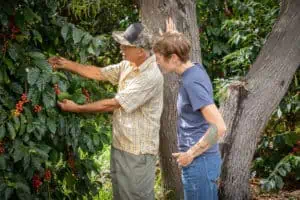
Roaster Heather Brisson-Lutz and farmer Gerry Ross at Kupa’a Farms. Courtesy of Origin Coffee Roasters.
From a local-rum-barrel-aged Puna Caturra to a Ka’u-grown coffee fermented with wine yeast, a washed-process Kenya-style SL28, and a honey-processed Ka’u Typica, the 10 coffees we review here signal the direction many Hawaiian coffee farmers are taking in the 21st century: careful, creative experimentation, thoughtful choices about varietals best suited for each microclimate, and an openness to exploring what Hawai’i coffee can be, without preconceptions. We even review a coffee, Greenwell’s Mamo, that represents a new hybrid variety developed exclusively in Hawai’i that is making its debut on the world coffee stage after two decades of research and testing.
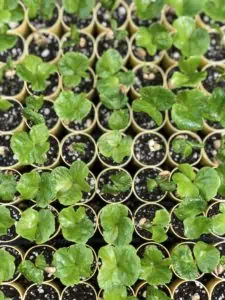
Baby Mamo trees in the nursery at Greenwell Estates. Courtesy of Tom Greenwell.
Nine of the 10 coffees here are from the Big Island and, of those, four are from the Kona District; four are from Ka’u; one is from Puna; and one is from the island of Maui. One was submitted by a roaster in Taiwan, and another by a New Orleans, Louisiana roaster whose mission is to elevate specialty Turkish coffee. Three were roasted by the producers who grew the coffees. (Producer/roasters are common on the Big Island, especially in Kona, but less common in the smaller Big Island growing regions.)
Hawai’i Coffees in a Global Context
Importantly, Hawai’i as a coffee-growing region is not bridled by the world commodity market (C-market) that sets the price of commodity-grade green coffee. The floating C-market price is determined by the mechanics of worldwide supply and demand for commodity Arabica coffee, but it affects producers of specialty coffee, as well, because it is a benchmark for price negotiation. The C-market has been under intense scrutiny recently because average production costs for coffee producers now unequivocally exceed the C-market price, a tragic discrepancy for small farmers who can only compensate by working harder and harder for less and less money.
But the prestige of the Kona name and the relative scarcity of Kona coffee create a separate market for Kona, in part freeing producers from the influence of the C-contract and giving them a great deal of autonomy, both in terms of pricing and product.
Kelleigh Stewart, co-owner of Big Island Coffee Roasters, says, “We’re removed from the C- market, so the feedback loop between producer and consumer here is short and direct. Our producers and industry professionals are often educated and have the resources to test variables. In Hawai’i, producers can test a new processing style, have it taste-tested by their end buyers, then set their own green/roasted prices based on the additional work involved. As producer/roasters, we have a wide breadth of responsibility, but we also have great creative freedom to explore.”
Paradise Roasters co-owner Miguel Meza adds, “Many Hawai’i producers travel to consuming markets and are familiar with things people in other parts of the world may be trying. Also like anywhere else in the world, producing coffee in Hawai’i for the general market is often not a profitable venture. So growers look to differentiate their product to be able to sell it at more profitable prices.”
Paterson says, “Everything is an option for the third wave,” and that, “When we created Kona Sweet [a natural-processed, sun-dried coffee] in 2008, we were advised not to do it because it wouldn’t be perceived as traditional enough,” he continues. We can report that we have tasted many iterations of that coffee here at Coffee Review and can say that the Hula Daddy rendition is one of the consistently cleanest naturals available, resonant with bright fruit, with none of the funk that often haunts natural coffees. It’s not a stretch to say that Hula Daddy has helped carve a path for broader acceptance of the natural process in specialty coffee, in general.
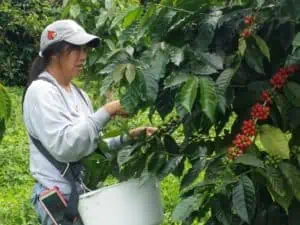
Karen Paterson picking coffee at Hula Daddy in Kona. Courtesy of Lee Paterson.
Paterson ticks off a list of the types of experimentation he sees routinely on the Big Island: “In Hawai’i, we have farmers using carbonic maceration, alternative fermentation liquids like Pepsi and sea water, and commercial yeasts. Many of the ideas for coffee-processing are coming from the wine industry.”
Origin Coffee’s founder Heather Brisson-Lutz, a mainland roaster who set up shop on Maui’s west side in 2018, works with both Hawai’i coffees and coffees from other world origins. She is seeing experimentation on Maui, as well, reporting that, “Olinda Farms has had great success with their controlled yeast inoculation during fermentation. It is challenging on Maui for smaller producers to take on natural- or honey-processing, due to our naturally rainy climate even in the ‘dry season.'” She works with Gerry Ross and Janet Simpson at Kupa’a Farms, upcountry in Kula, where she suggested they try a double-fermentation method widely used in Kenya (fermenting twice and washing twice in clean water). “Flash forward a month, and on my next visit to Kupa’a Gerry showed me the drying beds with Red Catuai, Yellow Catuai and Orange Bourbon separated in batches of single- and double-fermentation,” Brisson-Lutz says. She adds that, ” In general, I think producers see the value added by experimentation, whether it be in processing methods, fermentation or hybrids. They are creating a unique cup profile that attracts specialty coffee roasters and consumers.”
Joan Obra of Rusty’s Hawaiian, who moved back to Pahala (in the Ka’u growing region of the Big Island) to help her mom, Lorie Obra, run the family farm after her father died, says her mother asks one question when she approaches coffee processing: What does this coffee want to be? Joan says, “The answer depends on the variety, where it’s grown, the weather conditions for that year, processing type, and length of drying. Yeast is a fun new variable to add to those factors — and it falls in line with Lorie’s previous experiments. She has replaced the water in wet fermentation with seawater, pineapple juice, chili water, wine, soda, and other ingredients.” She says, “In short, we’re driven by curiosity. There’s an excitement around the cupping table when we taste the results of a new experiment for the first time.”
Four Standout Konas
Equator Coffee, based in the San Francisco Bay Area, sent us a gorgeous Kona coffee from Monarch Farms, owned by Greg and Susy Stille. It is experimental not by virtue of its processing (traditional washed) but by its variety, Gesha or Geisha. Long a darling of the elite specialty market, Gesha is being planted widely beyond Ethiopia (its origin) and Panama (where it was popularized), and this Gesha (which we rated 94) is floral and sweetly herbaceous with notes of aromatic orchid, spearmint and fine musk. Equator’s Director of Coffee, Ted Stachura, says, “There remains a mystique around Hawai’i coffees, in general, and Kona coffees, in particular. So many people from the U.S. mainland vacation on the islands and take away a positive feeling about the coffee as a result of their experience. Limited availability and high cost of production create an air of exclusivity, and you can’t get more exclusive than this award-winning Gesha lot.”
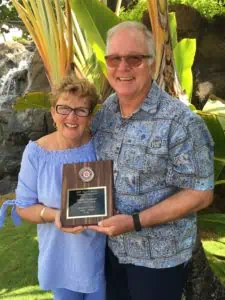
Greg and Susy Stille, co-owners of Monarch Farm in Kona, accepting an award from the Hawai’i Coffee Association. Courtesy of Abby Stille.
The most “classic” coffee here is perhaps a Kona Peaberry from Big Island Coffee Roasters, a conventionally wet-processed Kona Typica. It is also a peaberry, a kind of bean that results when the coffee fruit develops only a single, oval bean rather than the usual pair of flat-sided beans. This one, which we rated at 93, is rich-toned, with notes of black cherry, magnolia and a hint of thyme.
Hula Daddy submitted its Kona-grown version of the famous Kenya SL28 variety, Laura’s Reserve (93), a juicy-sweet cup with leading notes of red fruit and spice-toned sweet florals, backed up by buttery toffee.
Coming in at 90 is a true innovation, Greenwell Farms’ Mamo, a hybrid of the Maragogipe variety, famed for its huge beans, and the tiny-beaned Mokka, celebrated for its unique cup character. Mamo was developed over the course of 20 years by Dr. Chifumi Nagai of Hawai’i Agriculture Research Center (HARC); Hawai’i Coffee Growers Association (HCGA), under the direction of Kimo Falconer; and Tom Greenwell and his team at Greenwell Farms. The cup for this sample is sweetly savory, spice-toned and framed by rich aromatic wood notes. In regard to bean size, the Maragogipe parent appears to have prevailed here, as the beans are quite large.
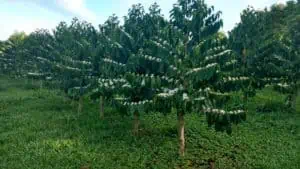
The first flowering of Mamo trees at Greenwell Estates. Courtesy of Tom Greenwell.
A Wild and Wacky Ka’u and the New Classic Ka’u Naturals
One of the most interesting coffees to land on our cupping table is Paradise Roasters’ Ka’u Champagne Natural, harvested by Meza himself from various farms in Ka’u, then fermented in the whole fruit using two different strains of wine yeasts, and dried in the whole fruit. Meza observed that, throughout the fermentation in water, there were a lot of bubbles as a result of the yeasts producing carbon dioxide. He says, “When tasting the cherries during fermentation, I noticed that they have a sparkling, effervescent sensation, and later in the fermentation when most of the sugar has been consumed, the fruit is bright and crisp like a dry sparkling wine.” We rated it at 94, finding it to be juicy, brightly fruit-toned and spicily floral, with notes of wild strawberry, honey, dried gardenia, pistachio butter and pink peppercorn.
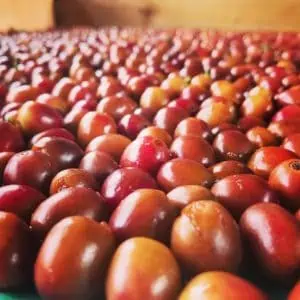
Miguel Meza’s experimental fermentation process at work on the Paradise Ka’u Champagne Natural. Courtesy of Miguel Meza.
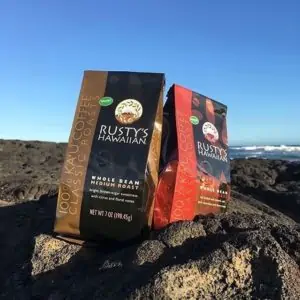
Rusty’s Hawaiian coffees at the beach. Courtesy of Joan Obra.
Three Ka’u coffees, two produced by Rusty’s Hawaiian and one produced by Rusty’s sister company, Isla Custom Coffees, impressed us with their cleanly bright fruit-forwardness and elegant balance. Rusty’s own Honey Typica scored 92, as did Three Chairs Typica Natural (produced by Rusty’s), roasted in New Orleans by a native of Turkey, Turgay YILDIZLI, whose primary focus is on elevating Turkish-style coffee within the specialty market. And Nine Point Coffee in Taiwan sent in a Ka’u Natural we rated at 93, sourced by Isla Custom Coffees from various Ka’u farms.
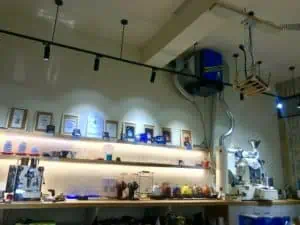
Nine Point Coffee Roasters in Taipei. Courtesy of Yu-Lin Chiu.
One could argue that the development over the last decade of high-quality Ka’u coffees that land somewhere on the natural-process spectrum, led by Lorie Obra and the Rusty’s team, argues for Ka’u as Hawai’i’s ground zero for these consistently graceful, cleanly fruit-expressive coffee styles.
A Maui and a Puna
Origin Roasters’ Orange Bourbon from Maui’s Kupa’a Farms (93) is notable for its crisply sweet-tart cup with pretty notes of peach, honeysuckle, cinnamon and cocoa nib, as well as for its backstory (see earlier in this report), in which local roaster Brisson-Lutz collaborated with the farmer to elevate and distinguish the cup profile.
Big Island Coffee Roasters sent us a Puna Caturra aged for two days in local Kuleana rum barrels as part of a series of barrel experiments with different coffees and vessels to explore, Stewart says, the influence on flavor, acidity and mouthfeel. I might add aroma to that list, as, right out of the gate, this coffee perfumed our cupping room with Concord grape and ginger blossom, along with some kind of barrel-treated alcohol we blind-identified as aged grappa. Surprisingly, the coffee itself is not overwhelmed by the barrel conditioning; it was brief enough that the coffee character is accentuated by the barrel, rather than dominated by it. We rated this coffee at 93.
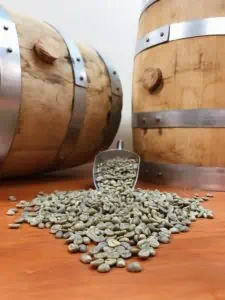
Big Island Coffee Roasters’ Puna coffee going into local rum barrels for aging. Courtesy of McKenzie Wildey.
By now quite apparent, the theme of this Hawai’i coffee report is experimentation, which has been encouraged by the islands’ unusual position in the global marketplace and by an infrastructure conducive to innovation. Stewart says, “To me, it feels like we’ve jumped from being a decade behind the specialty coffee movement to the forefront, just within the last five years.” We here at Coffee Review look forward to see how this exciting region continues to evolve.










